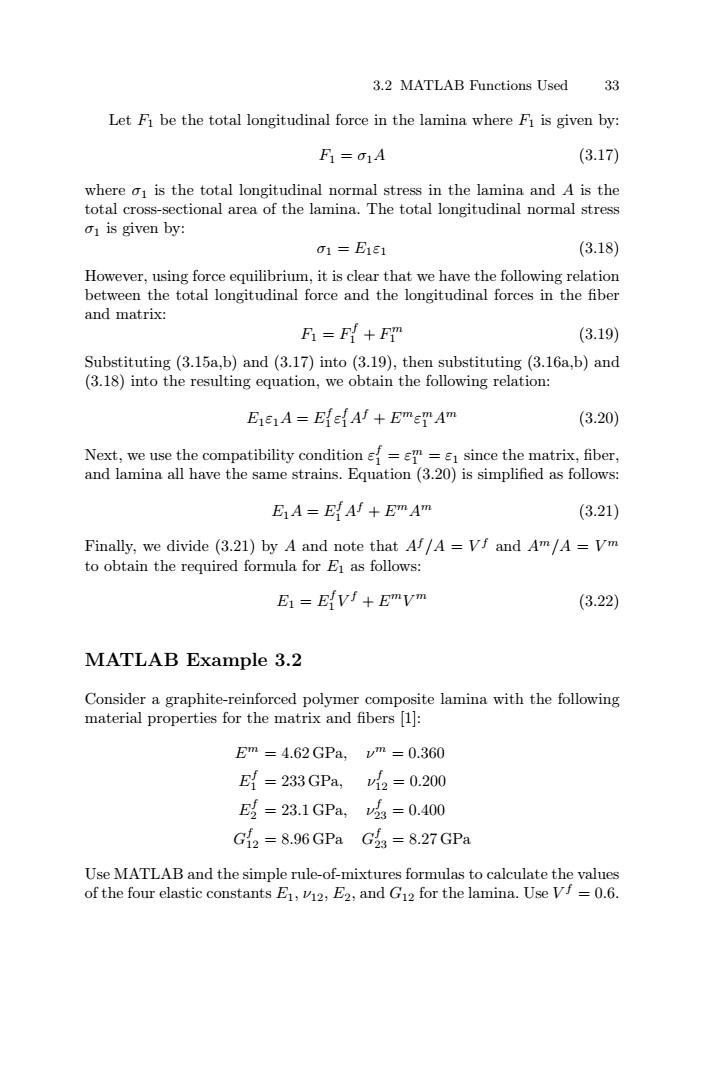正在加载图片...

3.2 MATLAB Functions Used 33 Let F be the total longitudinal force in the lamina where F is given by: F1=01A (3.17) where o1 is the total longitudinal normal stress in the lamina and A is the total cross-sectional area of the lamina.The total longitudinal normal stress o is given by: 01=E1E1 (3.18) However,using force equilibrium,it is clear that we have the following relation between the total longitudinal force and the longitudinal forces in the fiber and matrix: F=F+Fm (3.19) Substituting (3.15a,b)and (3.17)into (3.19),then substituting (3.16a,b)and (3.18)into the resulting equation,we obtain the following relation: E1E1A=EfEAf+Emem Am (3.20) Next,we use the compatibility condition e=em=since the matrix,fiber, and lamina all have the same strains.Equation(3.20)is simplified as follows: EA=E:A+Em Am (3.21) Finally,we divide (3.21)by A and note that Af/A=Vf and A"/A Vm to obtain the required formula for E as follows: E1=EV+Emvm (3.22) MATLAB Example 3.2 Consider a graphite-reinforced polymer composite lamina with the following material properties for the matrix and fibers [1]: Em=4.62GPa,ym=0.360 E=233GPa,2=0.200 E=23.1GPa,=0.400 G2=8.96GPaG3=8.27GPa Use MATLAB and the simple rule-of-mixtures formulas to calculate the values of the four elastic constants E1,v12,E2,and G12 for the lamina.Use Vf=0.6.3.2 MATLAB Functions Used 33 Let F1 be the total longitudinal force in the lamina where F1 is given by: F1 = σ1A (3.17) where σ1 is the total longitudinal normal stress in the lamina and A is the total cross-sectional area of the lamina. The total longitudinal normal stress σ1 is given by: σ1 = E1ε1 (3.18) However, using force equilibrium, it is clear that we have the following relation between the total longitudinal force and the longitudinal forces in the fiber and matrix: F1 = Ff 1 + F m 1 (3.19) Substituting (3.15a,b) and (3.17) into (3.19), then substituting (3.16a,b) and (3.18) into the resulting equation, we obtain the following relation: E1ε1A = Ef 1 ε f 1Af + Emεm 1 Am (3.20) Next, we use the compatibility condition ε f 1 = εm 1 = ε1 since the matrix, fiber, and lamina all have the same strains. Equation (3.20) is simplified as follows: E1A = Ef 1 Af + EmAm (3.21) Finally, we divide (3.21) by A and note that Af /A = V f and Am/A = V m to obtain the required formula for E1 as follows: E1 = Ef 1 V f + EmV m (3.22) MATLAB Example 3.2 Consider a graphite-reinforced polymer composite lamina with the following material properties for the matrix and fibers [1]: Em = 4.62 GPa, νm = 0.360 Ef 1 = 233 GPa, νf 12 = 0.200 Ef 2 = 23.1 GPa, νf 23 = 0.400 Gf 12 = 8.96 GPa Gf 23 = 8.27 GPa Use MATLAB and the simple rule-of-mixtures formulas to calculate the values of the four elastic constants E1, ν12, E2, and G12 for the lamina. Use V f = 0.6